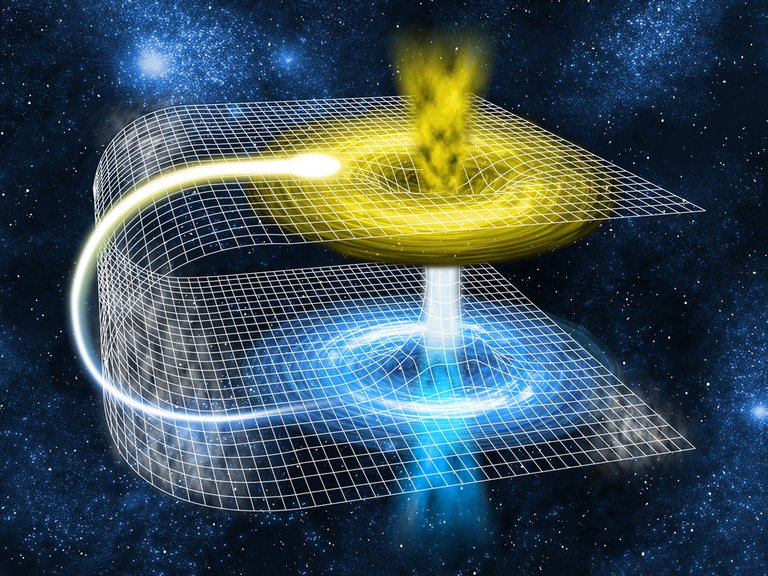What is a Wormhole?
Wormholes have captured science fiction’s imagination since at least the 1970s (Larry Niven and Jerry Pournelle’s The Mote in God’s Eye), and most famously in the ‘80s and ‘90s with the release of Carl Sagan’s Contact and the beginning of the Stargate franchise. But what is a wormhole, and do they have any foundation in real physics? First, a brief examination of black holes is required.
Black Holes
The term “black hole” was coined by John Wheeler in 1967, but the concept of a body so massive that even light cannot escape dates back to the late 18th century, and by the 1930s sophisticated equations by physicists like Einstein and Schwarzschild laid the groundwork for late-20th-century advances by scientists like Roger Penrose and Stephen Hawking.
Simply put, a black hole is formed when a star at least 10 times more massive than our sun collapses in on itself forming a boundary in spacetime (called the event horizon) from which matter and light cannot escape. Any form of matter or energy that slips beyond this event horizon falls inward toward the singularity at the heart of the black hole, beyond all recall or recovery.
Nothing can survive this “fall” as any object would be eventually stretched out and torn apart by the uneven acceleration experienced as it approached the singularity. For example, a person jumping feet-first into a black hole would eventually accelerate “downward” so rapidly that their feet would be close enough to the singularity to “outrace” their torso and head, stretching them like a rubber band, until eventually even their molecules were torn apart by the stress. As a result a fall into a black hole would cause a very unpleasant––and one-way––trip.
Wormholes
The theories behind wormholes developed in the early 20th century, similarly to black holes, though the term itself did not exist until 1957, and the possibility of traversable wormholes did not have a “real-world” foundation until the ’80s, through the work of physicists like Kip Thorne.
The basic concept of a wormhole can be envisioned by folding a sheet of paper over in a U-shape and punching a straw through the upper and lower sections. This would allow, say an ant, to walk only a short way along the paper, down the straw, and up to the other end of the folded-over paper, thus bypassing the majority of the surface of the sheet.
In the same way this 2-dimensional analogue can be extended into 3 (and 4) dimensions by imaging a conduit (like a tunnel) “punched through” the fabric of spacetime, connecting vastly distant regions (distant in both time and space), allowing for great distances to be covered in a fraction of the time it would take traversing “normal” space, and allowing for the possibility of time travel.
The problem is, however, that Einstein and Schwarzschild’s equations describe a class of constructs that do not actually last long enough to allow for the passage of even light (to say nothing of a spaceship!), and that, upon their collapse, inevitably crush anything trapped beyond the event horizon––essentially the other end of the wormhole gets “pinched-off” almost instantly, leaving said spaceship falling toward a now “dead-ended” black hole.
In 1988 Kip Thorne and his grad student Mike Morris worked out a class of wormhole that is held open by exotic matter (i.e. having negative mass), such as a hypothetical type of cosmic string that may have occurred naturally in the early universe. Such a wormhole might, theoretically, allow for (apparently) faster-than-light travel, since acceleration through the wormhole itself would be slower than the speed of light, but the “short-cut” effect would take a ship from point ‘A’ to point ‘B’ much faster than a beam of light could make the trip through normal space.
What about time?
Since time and space are intertwined, traversable wormholes could also allow for time travel by accelerating one end of the wormhole to nearly the speed of light relative to the other end. Relativistic time dilation (that is, the closer to the speed of light one accelerates, the slower time moves) would mean that anything entering the “fixed” end of the wormhole would emerge at the accelerated end at an earlier time. However, the theories do not allow for any further time travel than that––that is, you couldn’t go any further back in time that the moment the wormhole was created. It may also be that the accumulation of energy and particles in such a “time machine” wormhole would eventually “feed back” on itself, destroying it, but this is still an area of research and theorizing.
Conclusion
Wormholes, along with other faster-than-light models such as warp drive and hyperspace, have played an integral role in science fiction stories for decades, allowing intrepid explorers (or evil empires) to transcend the universe’s unimaginably vast expanses in mere moments. Real wormholes, given their highly speculative nature and the vast amounts of energy (some of it hypothetical) required to generate them, are certain to be much rarer (and likely dangerous) than their fictional cousins, but no less intriguing.
References
https://www.space.com/20881-wormholes.html
https://www.ccmr.cornell.edu/faqs/what-is-a-wormhole/
Posted with STEMGeeks
